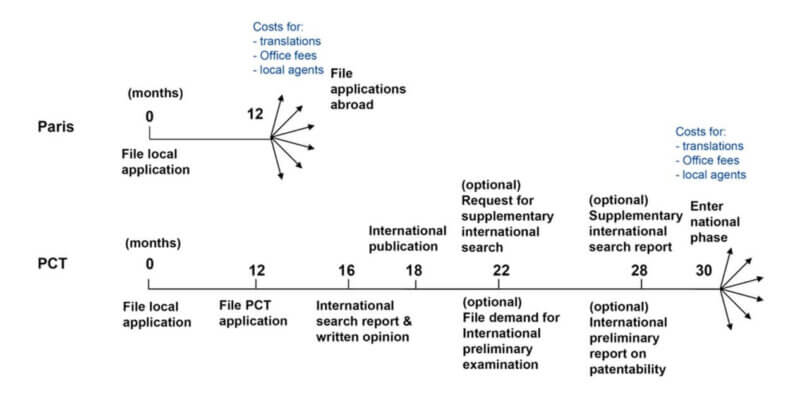Patent co-operation treaty – PCT application
A PCT (Patent Cooperation Treaty) application is an international patent application filed under the treaty. It enables simultaneous patent protection in multiple countries through a single application, delaying the need for individual national filings. It offers a centralized system, giving applicants extra time to choose countries for patent protection.
Table of Contents
Patents are territorial. which means if you have a patent for your invention in the United States (US) you cannot stop someone from making using selling offering for sale or importing your patented invention in some other country, that is other than US.
Now you may want to go for as many countries as possible to protect your invention.
If you go by the convention route (that is by the Paris convention) you need to file patent applications in all countries of your interest within 12 months from the date of filing of patent application in your home country.
The Paris Convention is an international treaty that allows applicants to file the first application in their home country. And within 12 months period, a further application called a Paris Convention application could be filed at desired countries.
Now for example you selected 10 countries to file your patent application, can you imagine the simultaneous workload? for doing all the steps in all the countries of your interest like replying to objections, requesting for examinations, translating your patent application into different languages, and ultimately professional charges of patent agents or attorneys involved at different patent offices and all this happening simultaneously !!!
this is what would happen if you take the traditional route for the international filing of your patent application. to avoid such chaotic conditions expenses and additional workload patent cooperation treaty was created.
The Patent Cooperation Treaty (PCT) is an international treaty with more than 150 Contracting States. The granting of patents remains under the control of the national or regional patent offices in what is called the “national phase”.
“PCT is administered by World Intellectual Property Organization WIPO, and it’s primary objective is to provide a system where you need to make only one patent application which would be searched by at least one International search authority and examined by at least one selected International Preliminary Examination Authority IPEA”

It is important to remember that pct does not provide the grant of patent it only facilitates a single application which would be taken from searching to examination stage centrally and which would be applicable for all the signatory countries in pct. Currently, the number of countries associated with PCT are 156.
How to get a patent in multiple countries?
Patents are territorial and you will have to get a patent granted in each country of your interest to be able to protect your invention there. Imagine the efforts and costs involved in getting your invention patented in each country
- different patent process
- translation costs
- patent writing costs in different languages
- different fees for filing a patent application in each country
- different office actions
- Attorney fees, etc.
What if there is a facility where at least some of the steps (if not all of the steps) in getting a patent for an invention in multiple countries would happen only once (which would be acceptable to all countries of interest…)
There is an answer to this… A PCT application for patent in multiple countries.
How PCT help in getting patent in multiple countries?
The PCT (Patent cooperation treaty) adheres to about 130 countries. This treaty is the result of an effort by many countries to provide some streamlining of patent applications across several countries at once. which allows the following benefits:
- By filing a PCT application, the applicant can postpone for 30 months (rather than 12 months under the Paris Convention) the decision in many countries about whether or to spend the money for foreign patent filings.
- The PCT process is helpful to those who don’t have enough money to file in several countries, but who expect to have enough money at a later time.
Any person who is a resident of a PCT member country can file a single PCT application which can effectively have the ability to proceed with all PCT member countries (in the national phase).
The initial stages with patent applications like
- Patentability search
- First Examination report
can be done in a designated country which can be selected by the patent applicant. This helps in saving a lot of time, effort, and costs for inventor/applicant of the patent: as the application of patent, request for examination, examination of patent, and report of examination happens at the single country (designated country) and has its effect on all member countries in PCT when the patent application enter into national phase at each country.
The PCT makes it possible to apply for patent protection for your invention simultaneously in a large number of countries by filing a single “international” patent application instead of filing several separate national or regional patent applications (as in the case of convention patent application).
when you file an International patent application to PCT, unlike the previous (convention application) option, your international patent application is valid for all 156 member countries of PCT (that is up to the international phase) and here you have about 30 to 31 months of time to decide whether to enter into the national phase of the country of the interest.
This decision depends on the international search and examination report. The international phase is the phase during which the international patent application is published, search, and examined before entry in the designated country (that is a national phase)
The national phase is the phase when International patent application enters the countries of interest. The international patent application is searched and examined by National patent offices and its granted or rejected
The procedure for PCT filing
- Filing: you file an international application with a national or regional patent Office or WIPO, complying with the PCT formality requirements, in one language, and you pay one set of fees.
- International Search: an “International Searching Authority” (ISA) (one of the world’s major patent Offices) identifies the published patent documents and technical literature (“prior art”) which may have an influence on whether your invention is patentable, and establishes a written opinion on your invention’s potential patentability.
- International Publication: as soon as possible after the expiration of 18 months from the earliest filing date, the content of your international application is disclosed to the world.
- Supplementary International Search (optional): a second ISA identifies, at your request, published documents that may not have been found by the first ISA which carried out the main search because of the diversity of prior art in different languages and different technical fields.
- International Preliminary Examination (optional): one of the ISAs at your request, carries out an additional patentability analysis, usually on an amended version of your application.
- National Phase: after the end of the PCT procedure, usually at 30 months from the earliest filing date of your initial application, from which you claim priority, you start to pursue the grant of your patents directly before the national (or regional) patent Offices of the countries in which you want to obtain them.
Advantages of PCT over convention application
- The pct provides the most effective and most economic way of filing a patent application in multiple countries
- It enables the application to file a single patent application with a single patent office in a single language having an effect in each country to pct
- The application is searched by international search authority
- It provides a formal examination of the international application by an international preliminary examination authority
- centralized International Publication of international patent application
- reduced load on patent officers by taking international patent application through searching and examination before entering into the national phase
The international phase is the phase during which the international patent application is published, search, and examined before entry into the designated country (that is national phase)
The national phase is the phase when the International patent application enters the countries of interest. The international patent application is searched and examined by National patent offices and its granted or rejected.
